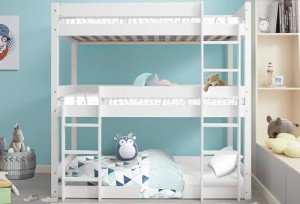A Comprehensive Guide to Children's Bunk Beds: Styles, Benefits, and Safety Considerations
Bunk beds have actually ended up being a popular choice for households seeking to optimize space and provide a fun sleeping environment for kids. With their distinct style, they provide an imaginative and useful service for shared bed rooms, playrooms, or perhaps guest lodging. This article explores the different styles of children's bunk beds, their benefits, security considerations, and answers some frequently asked concerns.
The Allure of Bunk Beds
Children's bunk beds are more than simply space-saving structures; they are also a gateway to adventurous dreams and imaginative play. Below is an in-depth evaluation of their numerous benefits.
Advantages of Bunk Beds
- Space-Saving: Bunk beds efficiently utilize vertical space, making them an ideal choice for smaller sized rooms.
- Spirited Design: Many bunk bed styles include slides, camping tents, and themed elements, stimulating creativity and enjoyment.
- Partner Sharing: Bunk beds are ideal for brother or sisters sharing a space or accommodating sleepovers.
- Versatile Use: Some models can be separated into 2 specific beds, offering flexibility as kids grow.
- Storage Options: Many bunk beds feature built-in drawer storage or shelves, even more improving their practicality.
Designs of Children's Bunk Beds
The variety of bunk beds available today accommodates various preferences and requirements. Below is an overview of some popular designs.
| Style | Description | Best For |
|---|---|---|
| Requirement Bunk Bed | A standard style including one bed stacked above another. | Siblings sharing a room. |
| Loft Bed | Similar to a bunk bed without the bottom bunk, permits an office or play area below. | Limited space for play/desk. |
| L-Shaped Bunk Bed | Two beds arranged in an L-shape, typically with additional sections for storage or play. | Distinct space designs. |
| Twin Over Full | A twin bed over a full bed, accommodating different sleep needs. | Growing kids and teens. |
| High Sleeper | Stands even higher than a loft bed, normally including a desk or play location below. | Older kids needing more play/desk space. |
| Camping Tent Bunk Bed | Bunk beds with a canopy or tent-like structure, developing a relaxing, fun space. | Active and creative children. |
Secret Features to Consider
When choosing the best bunk bed for kids, the following features are worth considering:
- Material: Bunk beds can be made from wood, metal, or a combination. Each has its unique visual and durability.
- Weight Capacity: Always confirm the weight limit of the bunk bed to guarantee it can accommodate your kids safely.
- Security Rails: Ensure the leading bunk has tough rails to avoid falls.
- Ladder Security: A properly designed ladder must offer easy and safe access to the upper bunk.
- Completing: Ensure any finishes are non-toxic and safe for children.
Security Considerations
Security is vital when it pertains to kids's bunk beds. The following standards should be adhered to:
- Age Appropriateness: Generally, children under 6 years old should not sleep in the upper bunk due to safety risks.
- Strong Construction: Ensure the frame and materials are strong and can support the weight without sagging.
- Routine Maintenance: Periodically look for loose screws, bolts, or other components that might need tightening up.
- Clear Play Area: Keep the location around the bunk bed without toys and obstacles to minimize tripping hazards.
Setting Rules for Safe Use
Establishing standards for bunk bed use will assist ensure security:
- Limit Jumping and Climbing: Children ought to be encouraged versus leaping from the leading bunk and climbing on the sides.
- Supervising Sleepovers: Monitor young guests while they are utilizing the bunk bed for the very first time.
- Inform on Ladder Use: Teach how to use the ladder safely, emphasizing the importance of dealing with the ladder when going up or down.
Frequently Asked Questions
1. What age is suitable for a kid to oversleep the leading bunk?
A lot of manufacturers suggest that children should be at least 6 years of ages to oversleep the upper bunk. This guideline is created to mitigate the risk of falls.
2. Can bunk beds be customized?
Yes, lots of makers use customizable choices, consisting of colors, products, and extra features like drawers or desks.
3. Are bunk beds safe for weight?
Bunk beds have weight limits, generally varying from 200 to 400 pounds, depending upon the design and product. Constantly inspect the producer's specifications.
4. How do I maintain and clean up a bunk bed?
Regularly look for loose parts, keep the bed clean by cleaning down surfaces, and ensure the bedding is fresh to promote a safe and sanitary sleep environment.
5. Can bunk beds be separated into specific beds?
Numerous bunk beds come with an option to separate them into 2 specific beds, supplying long-term versatility.
Children's bunk beds are more than mere furnishings; they are a functional, flexible, and imaginative element of a child's space. With various designs readily available and various safety factors to consider to bear in mind, parents can pick the ideal bed that fits their space, fulfills their kids's needs, and instills a sense of experience. By comprehending Bunk Beds Near Me maxbogus.top , designs, and safety measures associated with bunk beds, families can develop a delightful and protected sleeping environment for their children. Whether for brother or sisters sharing a space or space-saving options, bunk beds remain a beloved option for lots of homes.

